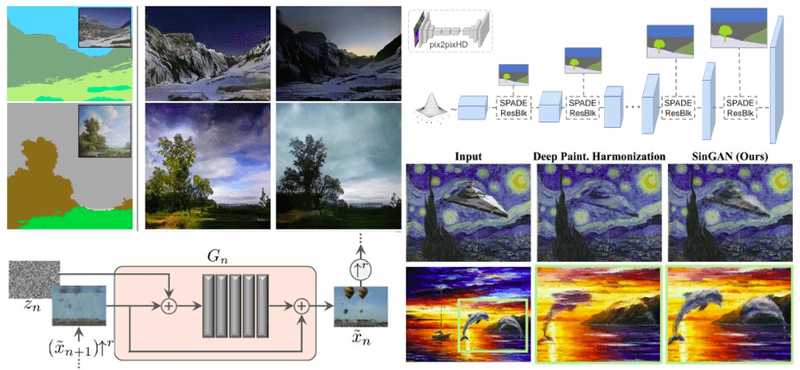
Mastering the Art of Image Synthesis
In the realm of digital creativity, Image Synthesis emerges as a revolutionary technique, unlocking the potential to craft synthetic realities that blur the lines between the virtual and the real. This article delves into the intricate world of Image Synthesis, exploring its applications, challenges, and the profound impact it has on shaping our visual experiences.
The Essence of Image Synthesis
At its core, Image Synthesis involves the generation of realistic images by artificial systems, often leveraging advanced algorithms and deep learning techniques. This process goes beyond traditional image manipulation; it entails the creation of entirely new visuals that mimic reality with astonishing accuracy. The essence lies in the ability to construct compelling, lifelike scenes from scratch.
Applications Across Industries
Image Synthesis finds applications across a myriad of industries, each harnessing its capabilities for various purposes. In the realm of entertainment and gaming, it enables the creation of immersive virtual worlds and lifelike characters. In product design and marketing, it facilitates the visualization of prototypes and concepts. Its versatility extends to fields like healthcare, where synthetic images aid in medical training and diagnostics.
Advancements in Deep Learning
The evolution of Image Synthesis is closely tied to advancements in deep learning, specifically through the use of generative models such as Generative Adversarial Networks (GANs) and Variational Autoencoders (VAEs). These models empower machines to learn intricate patterns from vast datasets, enabling them to produce high-fidelity synthetic images that closely resemble real-world visuals.
Challenges in Realism and Ethical Considerations
While Image Synthesis has made remarkable strides, challenges persist in achieving absolute realism. Issues such as the “uncanny valley,” where synthetic visuals appear almost but not quite real, pose obstacles. Additionally, ethical considerations related to the potential misuse of synthetic imagery for misinformation or deepfakes highlight the need for responsible development and usage.
Bridging the Gap in Virtual Environments
Image Synthesis plays a pivotal role in bridging the gap between the virtual and physical worlds. In virtual reality (VR) and augmented reality (AR) applications, the ability to create realistic and visually coherent environments enhances the immersive experience. Whether in gaming, training simulations, or architectural visualization, Image Synthesis contributes to creating convincing virtual spaces.
Crafting Synthetic Realities in Entertainment
The entertainment industry is a significant beneficiary of Image Synthesis. Filmmakers and animators leverage synthetic visuals to bring fantastical worlds to life, pushing the boundaries of what can be achieved on screen. The marriage of creativity and technology in Image Synthesis opens avenues for storytelling and visual expression that were once unimaginable.
Evolution in Architectural Visualization
In the realm of architecture and design, Image Synthesis revolutionizes the visualization process. Architects can now generate realistic renderings of structures and interiors before they are built. This not only aids in design exploration but also serves as a powerful communication tool for conveying ideas to clients and stakeholders.
The Role of Image Synthesis in Healthcare
Image Synthesis contributes significantly to the healthcare sector. Synthetic images play a crucial role in medical training, allowing practitioners to simulate surgical procedures and diagnostic scenarios. This technology enhances the educational experience for medical professionals, fostering a more immersive and hands-on learning environment.
Navigating the Future of Image Synthesis
Looking ahead, the future of Image Synthesis holds immense possibilities. Continued advancements in machine learning, the integration of real-time rendering techniques, and the refinement of generative models are poised to push the boundaries of synthetic visual creation. The ongoing innovation in Image Synthesis promises a future where synthetic realities seamlessly integrate with our visual experiences.
Exploring Image Synthesis on WickedFacts
To delve deeper into the world of Image Synthesis and its diverse applications, visit Image Synthesis. Explore the articles, insights, and discoveries that showcase the transformative impact of synthetic imagery on our perception of reality.
In conclusion, Image Synthesis stands as a gateway to crafting synthetic realities that captivate and challenge our visual senses. Its applications span industries, from entertainment and design to healthcare and beyond. Navigating the future of Image Synthesis requires a thoughtful approach, balancing innovation with ethical considerations to ensure that synthetic realities enrich rather than distort our visual experiences.




:max_bytes(150000):strip_icc()/terms_a_artificial-intelligence-ai_asp-FINAL-ddba8ac599f3438d8064350d2ee1ae5a.jpg)